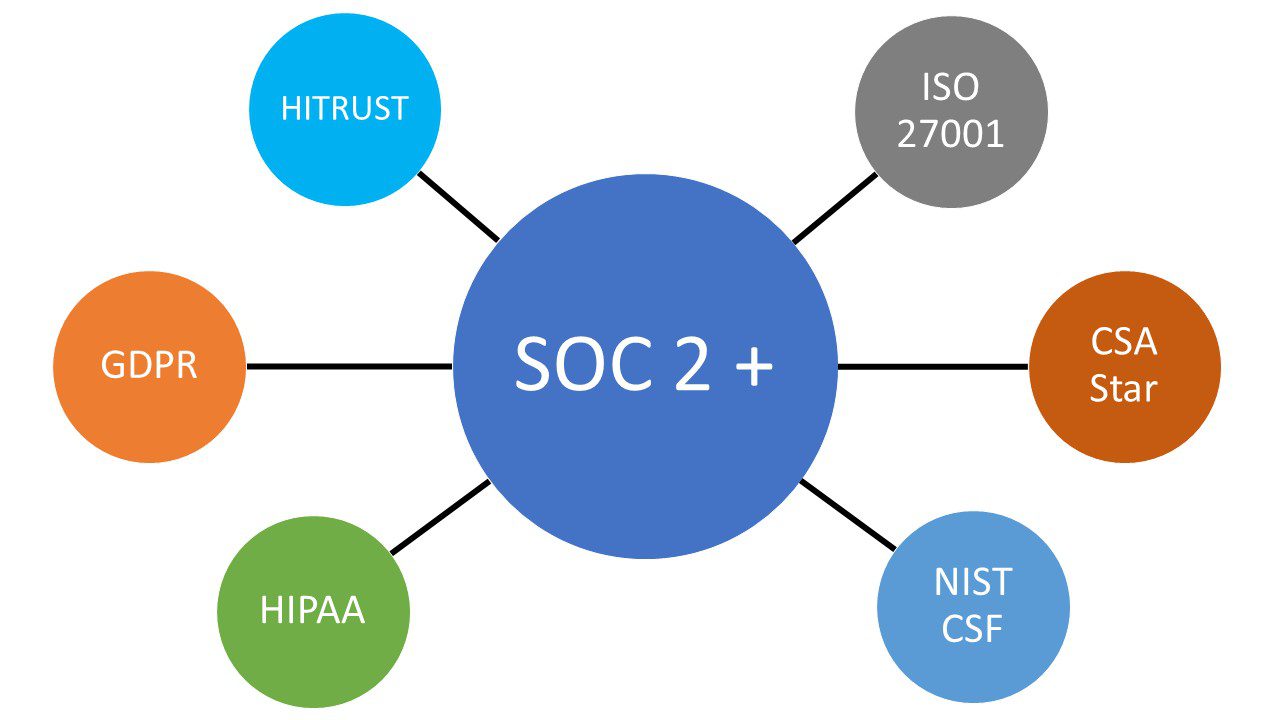While theoretically almost any framework could be turned into a SOC 2+ given sufficient controls to cover any areas the SOC TSCs do not cover, some frameworks naturally work better and already have mappings available.

SOC 2+ HITRUST
Through collaboration by HITRUST and the AICPA, a mapping between the two frameworks exists which maps the HITRUST CSF controls to SOC criteria for Security, Availability, Integrity and Confidentiality.
The scope for a HITRUST Assessment will be any system that stores or processes covered information. So, if your existing SOC scope does not cover all systems that process covered information, it may bring additional systems into scope.
For example, if an analytic tool is used to process covered information that may not be providing services to customers but holds patient data, it may bring that system into scope.
As a HITRUST Authorized External Assessor Organization for over 10 years, our team can guide you through the characteristics associated with SOC 2 and HITRUST assessments and the differences between them.
SOC 2+ ISO 27001
There are many ISO controls that map to one or more SOC criteria. However, not all do so new controls would need to be added to ensure the organization meets all ISO controls required for each objective. The controls that do map touch all 5 TSCs.
The scope of ISO 27001 covers the organization’s Information Security Management System, which is determined by conducting a risk assessment of the information the organization is protecting. As such, a SOC 2+ ISO report would need to cover both the intended SOC scope and the ISO scope of the organization’s Information Security Management System.
SOC 2+ CSA Star
About two-thirds of the Cloud Controls map either fully, or partially, over to the SOC TSCs. As such, the organization would have to review controls and potentially add additional controls to cover the full and partial gaps.
For example, this could mean updating controls to define a frequency that is in line with the CSA Star or adding a new control to cover a specific risk with working in a cloud environment addressed in the CSA. The mapped controls cover all TSCs.
The scope of a CSA Star Audit would cover all cloud resources an organization is using to provide its cloud services.
SOC 2+ NIST CSF
Almost all of the NIST CSF Subcategories can be mapped to the SOC TSCs, so any subcategories which do not directly map over would require additional controls to be identified. The controls that do map over, map to Security, Availability, and Confidentiality criteria.
The scope of NIST CSF covers the entire organization, so if your SOC scope is limited, your NIST CSF scope would also be limited. These items would be identified within the report.
Additionally, the NIST CSF aligns with certain regulatory requirements, such as HIPAA, so while not a 1 for 1 match, this could be used as a steppingstone to map an organization’s existing controls over to some of the data privacy laws.
SOC 2+ HIPAA
There is no direct mapping of SOC 2 TSCs to HIPAA Security or Privacy Rules that is publicly available, so a mapping of existing controls and newly generated controls will need to be developed. The rules cover all 5 TSCs.
The HIPAA Security Rule is strictly focused on the handling and management of personal health information (PHI) and is relevant to any organization that handles, interacts with, or manages PHI. As such, if your organization’s current scope does not address all systems that handle and manage PHI, the scope of the assessment would need to be expanded to include those systems and processes.
There is a mapping of the SOC TSCs to NIST CSF 1.1 which can then be aligned with the HIPAA Security Rule to better assist in the control identification.
SOC 2+ GDPR
There is a mapping of SOC 2 criteria to GDPR, however, most articles do not map, and additional control development will be needed. Of the controls that do map over, they map over to the Security and Privacy TSCs
Per the GDPR material scope, “This Regulation applies to the processing of personal data wholly or partly by automated means and to the processing other than by automated means of personal data which form part of a filing system or are intended to form part of a filing system.”
This would apply to any personal data of an individual within the European Union, regardless of where the data processor is located. The scope of GDPR is noted in Articles 2 & 3.

